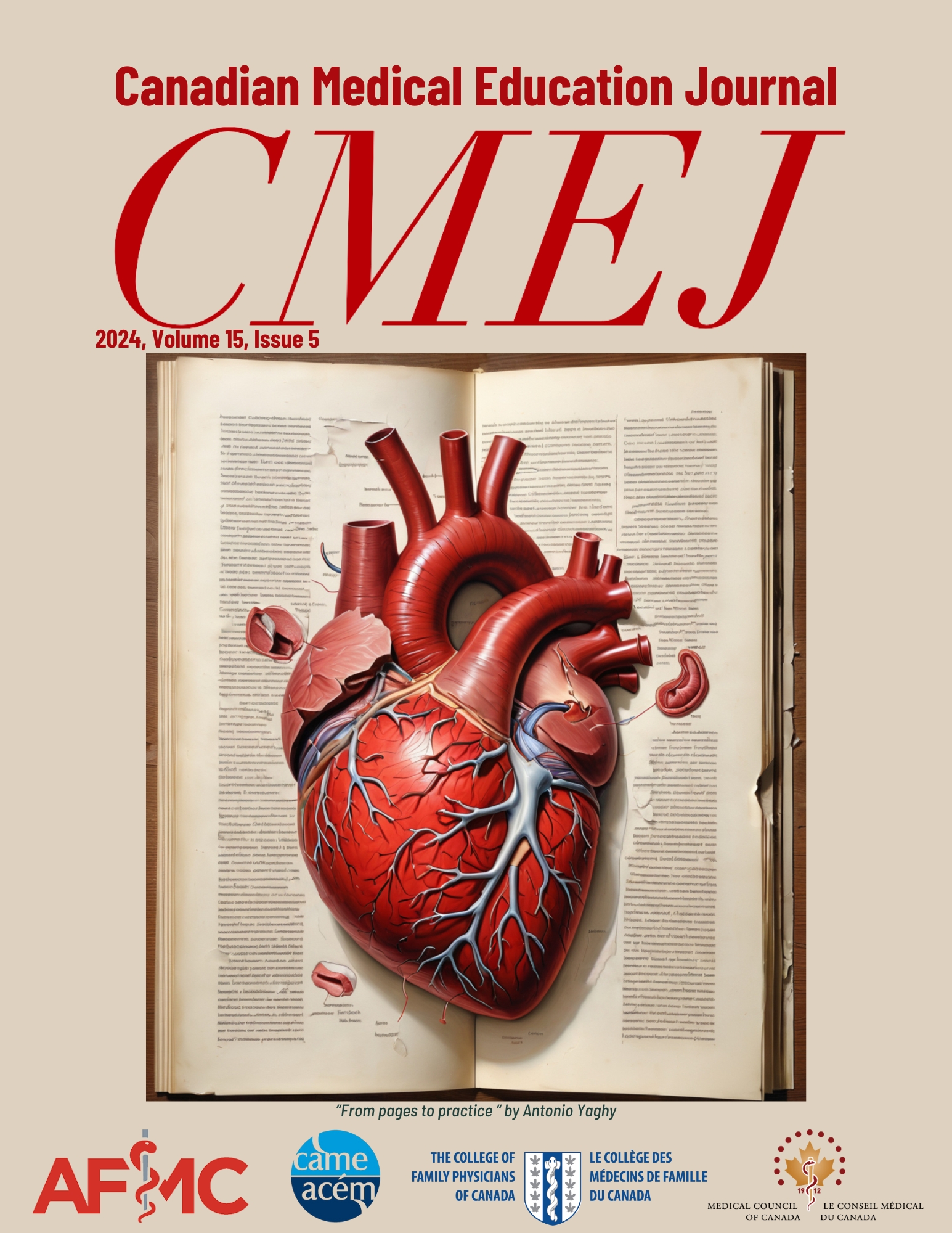Perceptions and reported use of extended reality technology in Royal College-Accredited Canadian Simulation Centres: a national survey of simulation centre directors
DOI:
https://doi.org/10.36834/cmej.79000Abstract
Background: Extended reality technology (XR) in simulation-based medical education is becoming more prevalent. This study examined Canadian simulation centre directors’ perceptions toward XR and their self-reported adoption of XR within their centres.
Methods: We conducted a national, cross-sectional survey study to examine five kinds of XR: Immersive Virtual Environments, Screen-based Virtual Worlds, Virtual Simulators, Immersive Augmented Reality, and Non-immersive Augmented Reality. An electronic survey with multiple-choice, Likert scales, and open-ended questions were developed to identify the current use, degree of satisfaction, and experienced and foreseen challenges with each XR technology. We used the Checklist for Reporting Results of Internet E-Surveys checklist to describe and justify our survey development. All twenty-three Royal College-accredited Canadian simulation centres were invited based on their Royal College membership to complete the survey. Directors and representatives of seventeen (74%) centres participated.
Results: Each XR has been used for research or simulation education by about half of the simulation centres, at minimum. The degree of satisfaction among directors with XR ranged from 30% to 45%. Directors frequently cited logistical and fidelity challenges, along with concerns over maintenance. Cost and lack of evidence, and unclear needs were cited as foreseen challenges with the future implementation of XRs.
Conclusions: This survey summarizes the status of XR in Canadian simulation centres. The pattern of use, satisfaction levels, and challenges reported by simulation centre directors varied depending on the types of XR.
Downloads
References
Barsom EZ, Graafland M, Schijven MP. Systematic review on the effectiveness of augmented reality applications in medical training. Surg Endosc. 2016;30(10):4174-83. https://doi.org/10.1007/s00464-016-4800-6.
Dhar P, Rocks T, Samarasinghe RM, Stephenson G, Smith C. Augmented reality in medical education: students' experiences and learning outcomes. Med Educ Online. 2021;26(1):1953953. https://doi.org/10.1080/10872981.2021.1953953
Jamal MH, Wong S, Whalen TV. Effects of the reduction of surgical residents’ work hours and implications for surgical residency programs: a narrative review. BMC Med Educ. 2014;14(1):S14. https://doi.org/10.1186/1472-6920-14-S1-S14.
Milburn JA, Khera G, Hornby ST, Malone PS, Fitzgerald JE. Introduction, availability and role of simulation in surgical education and training: review of current evidence and recommendations from the Association of Surgeons in Training. Int J Surg. 2012;10(8):393-8. https://doi.org/10.1016/j.ijsu.2012.05.005.
Harley JM, Hin-Hei Lau C, Bilgic E, Moran RM. Fried GM, Bhanji F. Identifying Royal College-accredited simulation centre research priorities across Canada. Can Med Ed J. 2023;14(4):89-93. https://doi.org/10.36834/cmej.73911.
Curran VR, Xu X, Aydin MY, Meruvia-Pastor O. Use of extended reality in medical education: an integrative review. Med Sci Educ. 2022;33(1):275-286. https://doi.org/10.1007/s40670-022-01698-4.
Abbas JR, Chu MMH, Jeyarajah C, et al. Virtual reality in simulation-based emergency skills training: a systematic review with a narrative synthesis. Resusc Plus. 2023;16:100484. https://doi.org/10.1016/j.resplu.2023.100484.
Meier AH. Running a surgical education center: from small to large. Surg Clin North Am. 2010;90(3):491-504. https://doi.org/10.1016/j.suc.2010.02.003.
Pruden C, Wadhwa R. Medical simulation center director as a system improvement leader. StatPearls. Treasure Island (FL): StatPearls Publishin Copyright © 2023, StatPearls Publishing LLC.; 2023.
Eysenbach G. Improving the quality of web surveys: the checklist for reporting results of internet e-surveys (CHERRIES). J Med Internet Res. 2004;6:e34. https://doi.org/10.2196/jmir.6.3.e34.
Rosseau G, Bailes J, del Maestro R, et al. The development of a virtual simulator for training neurosurgeons to perform and perfect endoscopic endonasal transsphenoidal surgery. Neurosurgery. 2013;73 Suppl 1:85-93. https://doi.org/10.1227/NEU.0000000000000112.
Peters TM, Linte CA, Yaniv Z, Williams J, editors. Mixed and augmented reality in medicine. 1st ed. CRC Press; 2018. https://doi.org/10.1201/9781315157702.
Chang TP, Sherman JM, Gerard JM. Overview of serious gaming and virtual reality. In: Nestel D, Hui J, Kunkler K, Scerbo M, Calhoun A, editors. Healthc Sim Res. Cham: Springer; 2019.
Harley JM, Bilgic E, Lau C, et al. Nursing students reported more positive emotions about training during Coronavirus Disease 2019 (COVID-19) after using a virtual simulation paired with an in-person simulation. Clin Simul Nurs. 2023;81:1-14. https://doi.org/10.1016/j.ecns.2023.04.006.
Maymone MBC, Venkatesh S, Secemsky E, Reddy K, Vashi NA. Research techniques made simple: web-based survey research in dermatology: conduct and applications. J Invest Dermatol. 2018;138(7):1456-1462. https://doi.org/10.1016/j.jid.2018.02.032.
Kardong-Edgren S, Farra SL, Alinier G, Young HM. A call to unify definitions of virtual reality. Clin Simul Nurs. 2019;31:28-34. https://doi.org/10.1016/j.ecns.2019.02.006.
Zhao Z, Niu P, Ji X, Sweet RM. State of simulation in healthcare education: an initial survey in Beijing. JSLS. 2017;21(1). https://doi.org/10.4293/JSLS.2016.00090.
Qayumi K, Pachev G, Zheng B, et al. Status of simulation in health care education: an international survey. Adv Med Educ Pract. 2014;5:457-67. https://doi.org/10.2147/AMEP.S65451.
Todd P. Chang, Debra Weiner. Screen-based simulation and virtual reality for pediatric Emergency medicine. Clin Pediatr Emerg Med. 2016;17(3):224-230. https://doi.org/e0.1016/j.cpem.2016.05.002.
Tsai A, Bodmer N, Hong T, et al. Participant perceptions of augmented reality simulation for cardiac anesthesiology training: a prospective, mixed-methods study. J Educ Perioper Med. 2023;25(3):E712. https://doi.org/10.46374/volxxv_issue3_Tsai.
Downloads
Published
Versions
- 2024-11-12 (2)
- 2024-08-12 (1)
How to Cite
Issue
Section
License
Copyright (c) 2023 Junko Tokuno, Elif Bilgic, Andrew Gorgy, Jason M Harley

This work is licensed under a Creative Commons Attribution-NonCommercial-NoDerivatives 4.0 International License.
Submission of an original manuscript to the Canadian Medical Education Journal will be taken to mean that it represents original work not previously published, that it is not being considered elsewhere for publication. If accepted for publication, it will be published online and it will not be published elsewhere in the same form, for commercial purposes, in any language, without the consent of the publisher.
Authors who publish in the Canadian Medical Education Journal agree to release their articles under the Creative Commons Attribution-Noncommercial-No Derivative Works 4.0 Canada Licence. This licence allows anyone to copy and distribute the article for non-commercial purposes provided that appropriate attribution is given. For details of the rights an author grants users of their work, please see the licence summary and the full licence.










